Tinos is a larger island in the northern Cyclades. Tinos has around 10,000 inhabitants and is just under 200 km² in size. Most tourists are Greeks, for whom Tinos is an important place of pilgrimage. The island is also known for sculpture. There are few foreign guests, but their numbers have grown in recent years.
Our opinion: Tinos exudes a calm and spiritual atmosphere that is particularly attractive for travelers looking for authenticity and contemplation. The sometimes strong winds and the less touristy infrastructure may take some getting used to for some visitors. Nevertheless, the island impresses with its traditional charm and the calm beauty of the landscape.
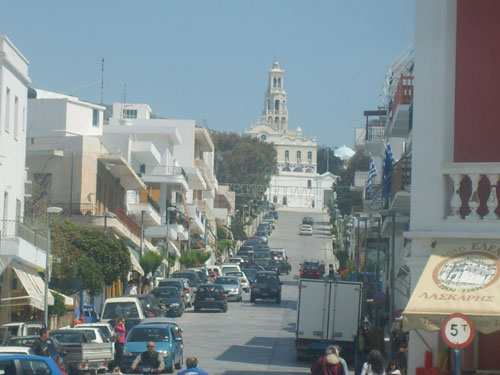
Where is the island of Tinos?
Tinos is an island in the Cyclades in the Aegean Sea in Greece. It is located:
Northwest of the island Mykonos (about 30 minutes by ferry)
Southeast of the island Andros
Northeast of the island Syros
Southeast of the Greek mainland (about 3-4 hours by ferry from Athens/Piraeus)
Tinos town
Pangia Evangelistria pilgrimage church
The many Greek guests on Tinos are pilgrims and come because of the famous Pangia Evangelistria pilgrimage church, which is known above all for its icons. In the Greek Orthodox faith, Tinos is about as important as Lourdes is for the Catholics – the most important place of pilgrimage. There is also said to have been an apparition of the Virgin Mary in Tinos. A year later (1823) the famous icon of the Virgin Mary was found. The Panagia Evangelistria Church was built on the site.
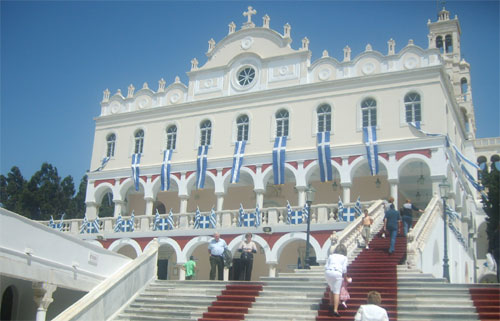
The basilica is open daily from about 8 a.m. to 8 p.m. However, it is only one of 1,000 (!) churches on Tinos. Church fans will have a real treat on the island. The church is located on a hill about 600 meters from the harbor and is visible from afar. The wide Megalochari road leads from the sea up to the church. On the right side of the road, many believers crawl up the street on their knees every day. Some of them wear knee pads to protect themselves when crawling on the bare asphalt. In the upper area, near the Panigia Evangelistria church complex, a red carpet is rolled out for the crawling pilgrims.

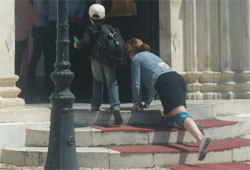
The main attraction of Tinos is visited by thousands of people every day. The whole complex with its many rooms is actually more reminiscent of a monastery. The sanctuary and the reason for the many Orthodox visitors to Tinos is the Panagia Megalocharis icon in the left room of the lower floor. Entry is free. Appropriate clothing is expected (long trousers, shoulders covered).
Downtown Tinos Town
The Odos Evangelistria, a small pedestrian zone to the right of the wide pilgrimage street, is also interesting for western tourists. Kitsch and souvenirs related to the church and religion are sold here. Many Greeks buy meter-long candles, which they then light in the church. At the beginning of this street by the sea are the travel agencies for ferry tickets.
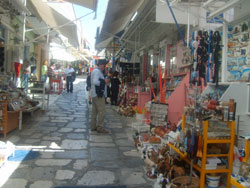
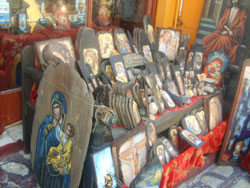
In the small but good archaeological museum in the Chora (town) of Tinos you can admire interesting finds from the island’s past. Otherwise the island is a typical nice port town. On the lively beach promenade you will find many taverns, especially fish restaurants. As business with pilgrims is booming, the prices in the taverns have risen significantly in recent years.
On the waterfront of Tinos town there are many larger hotels (mostly of the somewhat higher category). Further away from the shore you will find many houses that rent private rooms. The prices on Tinos are at least medium level. Around the two major holidays (see below) rooms are very expensive, otherwise you can always find a simple private room from 35 – 45 euros.
There is also a nightlife on Tinos, it is very Greek and is dominated by the local young people and the younger pilgrims from Athens.
Villages on Tinos
The small villages on Tinos are more interesting for some western tourists than the capital. The mountain villages around the highest mountain (Exobourgo, 730 m) are particularly worth seeing. Many of the villages are Catholic, Xinara even has a Roman Catholic bishop. You should definitely go to the mountain village of Pirgos in the north of the island. It is the village of marble sculpture. Many of Greece’s most famous sculptors live and work in Pirgos. The studios can be visited, and of course you can also buy the pictures. There are some beautiful beaches west of the capital. But Tinos is not exactly blessed with dream beaches.
Map of Tinos Island
|
There are several villages worth seeing on the island. The closest neighbour is the island of Andros. The very well-known tourist island of Mykonos is also not far away. |
Top 10 Tinos Attractions
Panagia Evangelistria Church: This famous pilgrimage site is known for its miraculous icon of the Virgin Mary. The large church is a central attraction, especially during religious festivals.
Pyrgos Village: The largest village on the island is known for its marble art. Stroll the narrow streets, visit the Marble Museum and watch local artisans at work.
Volax Village: A unique village surrounded by large, round granite blocks, it is known for its basket-weaving tradition and picturesque scenery.
Kolimbithra Beach: A popular beach for relaxing and water sports, including surfing. There are two beaches, a larger one with waves and a smaller, quieter one nearby.
Exomvourgo Mountain: A great place for hiking and exploring the ruins of an ancient Venetian castle. The views from the summit are stunning and offer panoramic views of Tinos and the surrounding islands.
Panormos Bay: This charming fishing village offers fresh seafood, a picturesque harbor and a peaceful setting. Ideal for a quiet getaway.
Pigeon houses: Scattered throughout the island, these traditional stone structures, originally used for pigeon breeding, are a unique feature of the Tinos landscape.
Isternia Village: Perched on a hill with spectacular views of the Aegean Sea, this village is famous for its marble architecture and narrow streets.
The beaches of Agios Sostis and Agios Romanos: These quieter beaches offer beautiful, crystal clear waters and a relaxed atmosphere, ideal for sunbathing and swimming.
Gastronomy: Try local delicacies such as louza (cured pork), artichokes and cheeses such as kopanisti. Visit traditional tavernas to experience Tinos cuisine.
Buses on Tinos
Numerous buses travel to most villages every day on the well-developed road network. The bus station is in the center of Tinos town, not far from the harbor. Island tours are also offered during the season.
Bus timetable for all buses to and from Tinos town
All buses are operated by the state-owned company KTEL, as is the case almost everywhere in Greece. The following timetable for the island of Tinos is an example; it is older, but similar every year. In winter there are significantly fewer buses:
Tinos town to Porto: 08:00 10:00 12:00 14:00 16:00 17:00 18:00 19:00
back: 08:10 10:10 12:10 14:10 16:10 17:10 18:10 19:10
About half of the buses stop at Agios Sostis beach on the way.
to Agios Fokas: 11:15 12:15 13:15 14:15 15:15 16:15 17:15 18:15
back: 11:20 12:20 13:20 14:20 15:20 16:20 17:20 18:20
to Kionia: 07:50 10:30 11:30 12 30 13:30 14:30 15:30 16:30 17:30 18:30
back: 07:55 10:35 11:35 12:35 13:35 14:35 15:35 16:35 17:35 18:35
to Kalloni: 06:40 14:00
back: 07:10 14:30
There are no buses on this route at weekends (Saturday, Sunday and public holidays).
There are stops on this bus route, for example in the villages of Tripotamos Loutra Komi and Agapi.
T-Town to Panormos (e.g. via Kambos Kardiani Pirgos and Marlas): 06:15 (Monday to Friday only) 11:00 14:00
return: 07:00 (Monday to Friday only) 11:45 14:45
T-Town via Monastery to Potamia: 06:40 10:45 14:00 16:00
return: 07:00 11:15 14:30 16:30
These KTEL buses also stop in Arnados, Mesi and Falatados.
Accommodation
The room prices on Tinos vary greatly depending on the season. Especially during the big religious festivals, it is very difficult to get a room if you have not booked well in advance. You can get a very good overview of many accommodations on Tinos, including the option to book, at Booking.com. Most accommodations are family pensions in Tinos town, but you can find a room in almost every village on Tinos. We like the Agapi Hotel Tinos right in the center of the island’s capital.
Ferries
As the mainland is not far away, the quickest and cheapest way to get to Tinos is from Rafina (east of Athens, 4 times a day). At least 2 ferries a day also travel to Tinos from the large Athens ferry port of Piraeus during the season. 3-5 ferries a day travel to nearby Mykonos and Andros. Tinos is well connected to Syros by sea (at least once a day). Ferries travel to the large Cycladic islands of Paros, Naxos and Santorini several times a week. Strangely, there are no ferry tickets available at the port of Tinos – only in the town (about 600 meters away). Ferry tickets to the neighboring islands of Mykonos, Syros and Andros cost less than 10 euros. Day trips from Mykonos to Tinos are very popular.
➔ To book ferries within Greece, we recommend the reputable website Ferryscanner.com
There is no airport on Tinos, just a helicopter landing pad for emergencies and millionaires.
Festivals
The two major pilgrimage days on Tinos are March 25th and August 15th (Assumption of Mary). These are of course the most interesting days to visit the island. Tens of thousands come to the island – special ferries are even used from Athens. Unfortunately, it is impossible to find a room on Tinos on these two days. With a bit of luck, you can get a ferry ticket that takes you from the neighboring islands of Mykonos or Syros to Tinos in the morning and back again in the evening.
Do you have any feedback, an addition, found an error or a comment? Send us an email to: mail@griechenland-insel.de